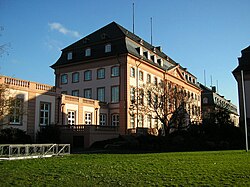New Zeughaus (Mainz)
The New Armory next to the Teutonic Order in Mainz is the current seat of the State Chancellery of Rhineland-Palatinate .
Construction and history
The baroque building was built from 1738 to 1740 under the chief building director and fortress builder Johann Maximilian von Welsch as an armory and is in the context of a number of buildings that still define the cityscape today. The first floor used to be a weapons room, where weapons and military equipment were stored and repaired. There were two oil paintings, floor plan of the Mainz Vestung, with the coat of arms of Elector Philipp Karl von Eltz , carried by two angels , including allegorical figures and a perspective order from the city of Mayntz on the facade of the armory against the Rhine , with allegorical figures of the Rhine and trade. The triangular gable above the center of the facade is adorned with the god of war Mars , designed by Burkard Zamels , and the coat of arms of the Elector von Eltz, with a leaping lion and a Mainz wheel. The building is covered by a mansard roof.
On the part facing midnight, the city side, formerly called Zum Sautanz , two pillars of the bridge that Charlemagne had built between 803 and 813 were found in 1736 and 1740 . This 500 meter long bridge was aligned to the Kasteller Amtshaus. Corresponding pillars were also found there. In March 1858, when the water level was low, the remains of 19 river pillars could be viewed. This is documented in Wittmann's chronicle of the lowest water levels in the Rhine. Today the Theodor-Heuss-Brücke leads directly to the New Armory and only turns in the immediate vicinity.
Although the arsenal was actually a functional building, it is equipped with the architectural elements of a palace. Welsch based itself on the structural elements of the neighboring Deutschhaus . The arched windows on the ground floor are provided with wrought iron bars for protection. They are provided with warlike attributes and show coats of arms, flags and shields. The windows on the upper floor are decorated with helmets. Two large gates open to the Rhine, where guns and other heavy military equipment could be made available for transport by ship. In place of the current bridge there were ship landing stages before the Rhine regulation .
Location
The location for this arsenal was based on the proximity of the barracks of the electoral troops, who could, among other things, drill on the palace square of the electoral palace . At the same time, the Rhine crossing was protected by the strategically important ship bridge. The nearby Mühlpforte was an important part of the city fortifications. The building is in alignment with the Deutschhaus.
A vital facility
- In the shortest possible time, Colonel Douay, director of the armory, Lieutenant Colonel la Riboissure Unterdirektor and Lieutenant Colonel Varin, chief of engineers, hand over their weapons, ammunition, tarpaulin etc. to the chiefs of the artillery and engineer of the Prussian army according to the war conditions that are incumbent on them .
- Surrender point XII., Which the General of the Brigade d'Oyré , commandant en chef of Mainz and Kastel agreed with the Prussian leadership in 1793 to end the siege of Mainz .
- Source: Privileged Mainzer Zeitung, No. 1 of July 29, 1793.
Todays use
Since 1956, the New Armory has been expanded and converted into the Rhineland-Palatinate State Chancellery . It was not until 1960 that the State Chancellery was able to move into the restored building, having previously been housed in the Bassenheimer Hof . For this purpose, the building, which was destroyed in the Second World War except for the basement and outer walls, was expanded inside with four, instead of two, floors. The mansard roof was also used as an office floor. Only the part of the upper floor facing the Rhine was retained in its dimensions and is now used as a ballroom for state receptions.
The Stresemann Hall is also located in the building, where the cabinet meetings take place and which the Stresemann Society uses for events. In the cabinet room there is a blackboard with three quotes from Aristide Briand , Sir Austen Chamberlain and the namesake Gustav Stresemann.
“Ici nous ne sommes que des européens. Il ya là la consécration du génie de l'Europe. "
"This is a turning point in the history of europe and it may be in the history of the world."
(Translation of the Chamberlain quote: This is a turning point in the history of Europe and perhaps in world history.)
“This great age is not just about people-to-people relationships. It's about an idea. That is more than just a phrase about an idea of European culture. To an idea of human development. "
Web links
- The new armory in Mainz by Bernhard Peter (especially on the coat of arms reliefs)
Coordinates: 50 ° 0 ′ 18 ″ N , 8 ° 16 ′ 19 ″ E



